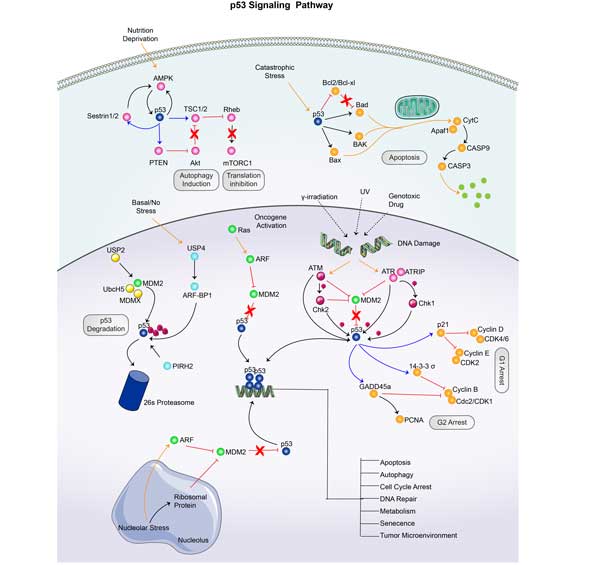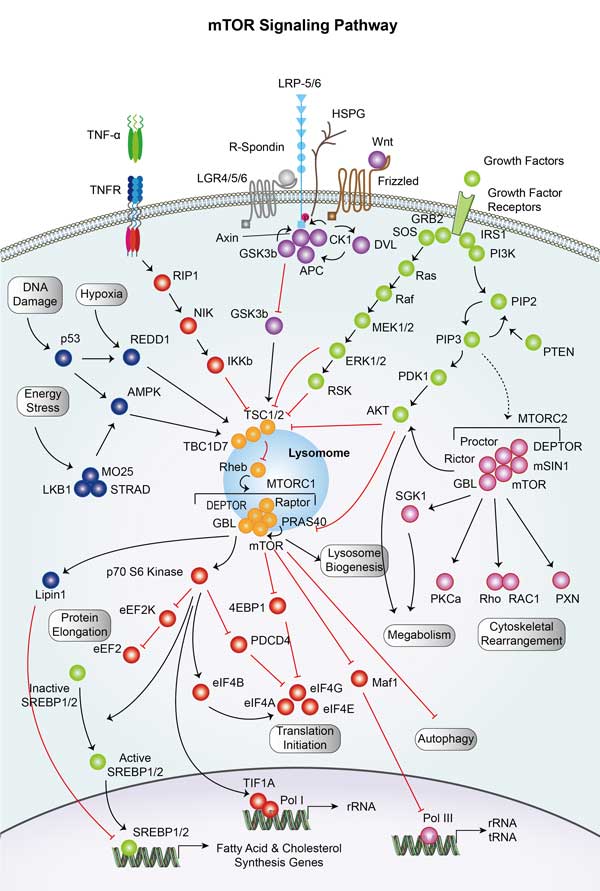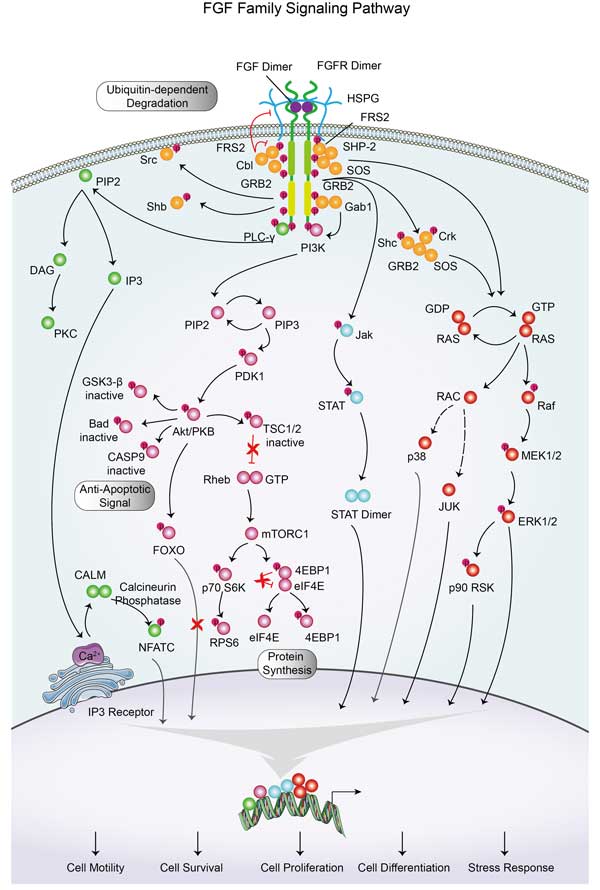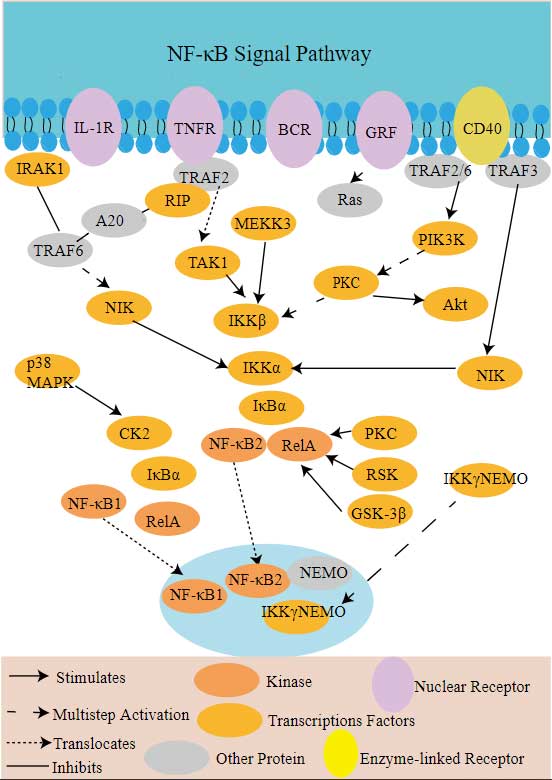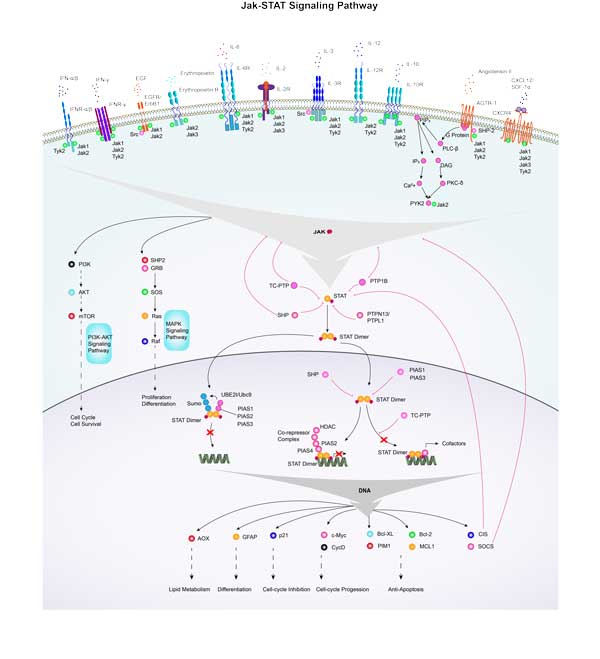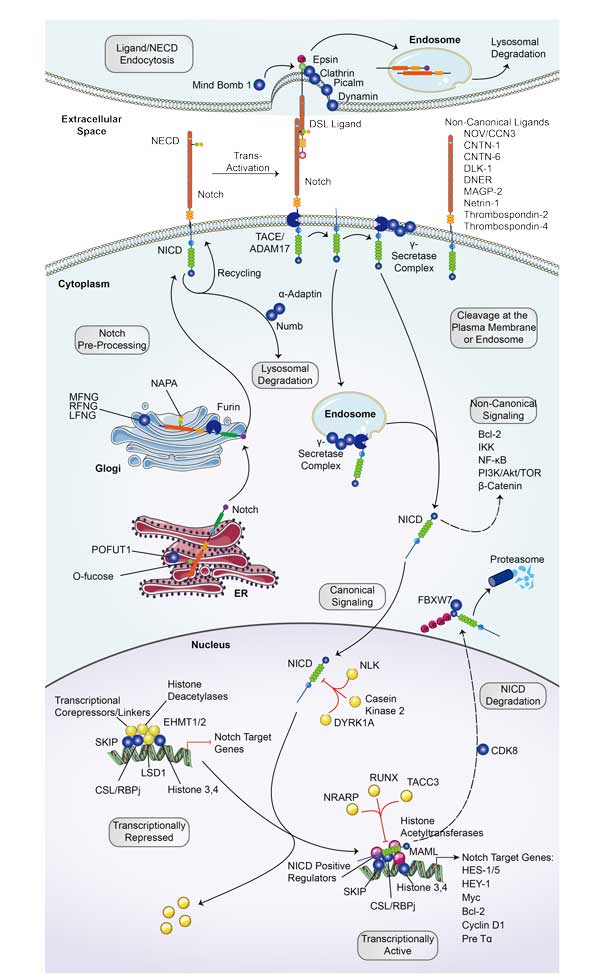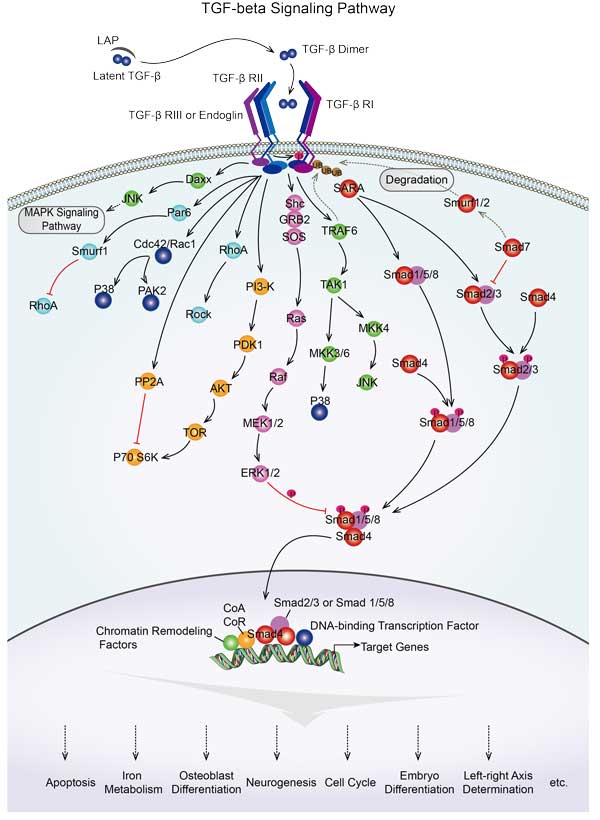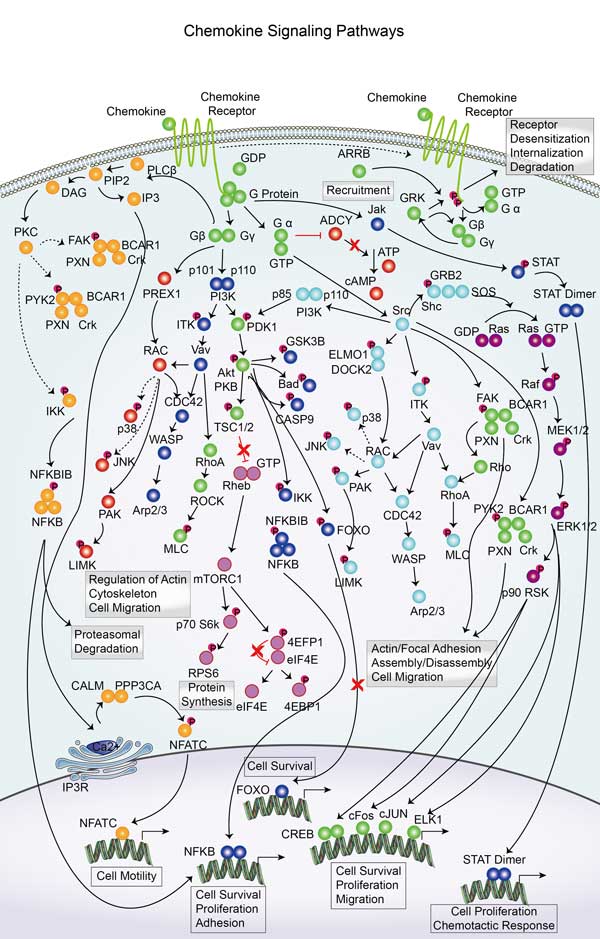AKT1
-
Official Full Name
RAC-alpha serine/threonine-protein kinase -
Overview
Akt(protein kinase B, PKB) is a serine/threonine protein kinase. Akt is activated by PI3 kinase, which is itself activated by tyrosine kinase (Thr308, Ser473). Akt/PKB controls vital cellular functions such as cell survival/apoptosis, cell cycle progression and glucose metabolism. It also acts down-stream from growth factors and hormones. Akt/PKB can inhibit cell cycle arrest by phosphorylating p21. Also, Akt/PKB may potentiate cell cycle progression through increased translation of cyclin D. Akt/PKB directly affects the apoptosis pathway by, for example, targeting the pro-apoptotic Bcl-2 related protein, BAD. It also can phosphorylate three kinases upstream of SAPK. The SAPK system consists of two groups of kinases, and JNK and p38 MAP kinase pathways. The SAPK pathway is an important target for Akt/PKB regulation to promote cell survival. Akt/PKB is able to regulate cell survival through transcriptional factors(Forkhead, nuclear factor-kB(NF-kB), Murine double minute 2(Mdm2)) that are responsible for pro- as well as anti-apoptotic genes. One of the first physiological targets of PKB to be identified was glycogen synthase kinase-3(GSK3), which has been associated with the control of many cellular processes, including glycogen and protein synthesis, and the modulation of transcription factor activity. The involvement of Akt in disease processes like malignancy, neurodegeneration and abnormal glucose metabolism has also been demonstrated. -
Synonyms
AKT 1;AKT 2;AKT 3;AKT1;AKT2;AKT3;C AKT;CAKT;DKFZP434N0250;v-akt murine thymoma viral oncogene homolog 1;Murine thymoma viral (v akt) homolog 2;murine thymoma viral (v akt) oncogene homolog 1;Murine thymoma viral (vakt) oncogene homolog 1;PKB Akt;PKB alpha;PKB;PKB beta;PKBalpha;PKBBETA;PKBG;PRKBA;PRKBB;PRKBG;Protein kinase Akt 2;Protein kinase Akt 3;Protein kinase B;Protein kinase B beta;Protein kinase B gamma;RAC alpha;RAC alpha serine/threonine protein kinase;RAC;RAC beta;RAC beta serine/threonine protein kinase;RAC gamma;RAC gamma serine/threonine protein kinase;RAC PK alpha;RAC PK beta;RAC PK gamma;Rac protein kinase alpha;Rac protein kinase beta;RAC Serine/Threonine Protein Kinase;Serine threonine protein kinase Akt 3;STK 2;STK2;V AKT Murine Thymoma Viral Oncogene Homolog 1;v akt murine thymoma viral oncogene homolog 2;v akt murine thymoma viral oncogene homolog 3;VAKT Murine Thymona Viral Oncogene 1
Recombinant Proteins
- Human
- Mouse
- Rhesus macaque
- Rat
- Chicken
- Zebrafish
- E.coli
- Insect Cells
- Sf9 Cells
- Insect cells
- Mammalian Cells
- HEK293
- In Vitro Cell Free System
- Protein Modification
- Mouse
- Rabbit
- GST
- His
- Non
- DDK
- Myc
- MBP
- Flag
- Avi
- Fc
Involved Pathway
AKT1 involved in several pathways and played different roles in them. We selected most pathways AKT1 participated on our site, such as MAPK signaling pathway,ErbB signaling pathway,Ras signaling pathway, which may be useful for your reference. Also, other proteins which involved in the same pathway with AKT1 were listed below. Creative BioMart supplied nearly all the proteins listed, you can search them on our site.
| Pathway Name | Pathway Related Protein |
|---|---|
| Colorectal cancer | TGFBR2,CASP9,AXIN2,RALGDS,ARAF,RAC3,FOS,Casp3,PIK3R2,TCF7L2 |
| VEGF signaling pathway | MAP2K1,PRKCBB,PPP3CA,PRKCB,PRKCA,MAPKAPK3,RAC3A,VEGFAA,MAPK12A,HRASA |
| Melanoma | FGF4,KRAS,HGF,PIK3R5,HRAS,FGF2,PIK3CD,PDGFRB,FGF18,PIK3R3 |
| Osteoclast differentiation | MITF,SIRP-BETA,SQSTM1,NCF2,RELB,BLNK,PIK3CB,AKT2,MAPK11,RAC1 |
| Epstein-Barr virus infection | POLR3E,H2-Q10,NCOR2,CSNK2B,HLA-DRB3,POLR3F,SHFM1,NFKB1,ICAM1,POLR2G |
| Proteoglycans in cancer | ARHGEF12,CDC42,NRAS,FASLG,SDC1,WNT6,RAF1,EZR,RPS6KB2,FLNA |
| cGMP-PKG signaling pathway | ATP1B1,IRS1,PIK3CD,PDE5A,ATP1A2,ROCK2,PDE2A,PIK3R2,KCNMB3,CREB3L3 |
| Toll-like receptor signaling pathway | MAP2K2,TLR7,STAT1A,CXCL11,STAT1B,IFNAR1,IRF7,TLR1LA,IFNB,TRAF3 |
| Insulin signaling pathway | MAP2K2,EIF4EA,MAP2K2B,SOS1,RPTOR,MAP2K1,PPP1CBL,PCK1,EIF4E2,CALM3B |
Protein Function
AKT1 has several biochemical functions, for example, 14-3-3 protein binding,ATP binding,enzyme binding. Some of the functions are cooperated with other proteins, some of the functions could acted by AKT1 itself. We selected most functions AKT1 had, and list some proteins which have the same functions with AKT1. You can find most of the proteins on our site.
| Function | Related Protein |
|---|---|
| protein serine/threonine/tyrosine kinase activity | SGK1,DYRK2,DYRK3,RPS6KB1,TTK,CLK4,DYRK4,PRKACA,RPS6KA1,RPS6KA2 |
| 14-3-3 protein binding | SRPK2,PRKCZ,TSC2,ARRB2,ZFP36,PPP1R12A,HDAC7,AANAT,YWHAQ,IRS2 |
| protein kinase activity | AKT3A,ARAF,STK35L,JAK2,RPS6KA3A,MAP3K14,TLK1B,ULK1A,NPRL2,MAP2K2A |
| protein phosphatase 2A binding | GRIN3A,STRN,PTPN1,ENSAA,PPP2R2A,PPME1,STRN4,RPS6KB1,CTTNBP2NL,ANKLE2 |
| phosphatidylinositol-3,4,5-trisphosphate binding | D6WSU116E,COMMD1,GAB2,RACGAP1,OGT,PIRT,ARHGAP9,RS1,ASAP1,MYO1G |
| protein serine/threonine kinase activity | MAST2,IRAK4,CLK2,NEK11,ADCK1,DSTYK,SLKA,SGK2A,CSNK1A1,DYRK1A |
| nitric-oxide synthase regulator activity | HSP90AA1,CALM3,HSP90AA1.1,ESR1,CALM2,HSP90AB1,CALM1 |
| kinase activity | PKN2,HYKK.2,PINK1,CAMK2B1,PI4KAB,ALPK2,cka1,SPS2,BAIAP2L1A,RAF1A |
| identical protein binding | VEGFA,CD74,BNIPL,MCM6,C1QTNF9,CCDC91,RELA,SCUBE1,NIF3L1,MCM10 |
Interacting Protein
AKT1 has direct interactions with proteins and molecules. Those interactions were detected by several methods such as yeast two hybrid, co-IP, pull-down and so on. We selected proteins and molecules interacted with AKT1 here. Most of them are supplied by our site. Hope this information will be useful for your research of AKT1.
MDM2;N/A;PPP2CA
AKT1 Related Signal Pathway
Resources
Research Area
- Cancer Drug Targets
- Kinases and Phosphatases in Endothelial Cells
- Apoptosis Intracellular Kinases
- Diabetic Peripheral Neuropathy
- Intracellular Kinases in the Akt Pathway
- Growth Hormone/IGF-I Axis
- Akt Isoforms
- Intracellular Signaling Molecules in Angiogenesis
- Melanoma Biomarkers
- Oncoprotein-Signal Transducers
- PI3K Pathway
Related Services
Related Products
References
- Chen, TC; Lin, KT; et al. Using an in Situ Proximity Ligation Assay to Systematically Profile Endogenous Protein-Protein Interactions in a Pathway Network. JOURNAL OF PROTEOME RESEARCH 13:5339-5346(2014).
- Al-Jarallah, A; Chen, X; et al. High Density Lipoprotein Stimulated Migration of Macrophages Depends on the Scavenger Receptor Class B, Type I, PDZK1 and Akt1 and Is Blocked by Sphingosine 1 Phosphate Receptor Antagonists. PLOS ONE 9:-(2014).


